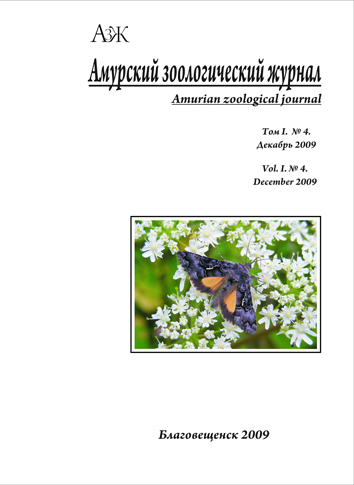SEXUAL DIMORPHISM OF LOWER AMUR GRAYLING THYMALLUS TUGARINAE (THYMALLIDAE)
DOI:
https://doi.org/10.33910/1999-4079-2009-1-4-386-391Keywords:
Lower Amur grayling, Thymallus tugarinae, Thymallidae, sexual dimorphismAbstract
Data on sexual dimorphism in morphology and biology of Lower Amur grayling Thymallus tugarinae from Anyui River (right tributary of Lower Amur) are presented. Mature males are larger than even-aged females and have more intensive body and fins coloration. Differences in fins size, in several body proportions and lower jaw length are detected. Sexual dimorphism of Lower Amur graylings from Anyui and Khor Rivers and from Sakhalin Island is characterized with a number of variations probably indicating geographical variability of this phenomenon.
References
Антонов А.Л. Материалы о новых лососевидных рыбах из притоков амура // Чтения памяти Владимира Яковлевича Леванидова. Вып.1 Владивосток: Дальнаука, 2001. С. 264-268.
Зиновьев Е.А. Экология и систематика хариусовых рыб Евразии: автореф. дис. докт... биол. наук. Пермь. Пермский гос. ун-т, 2005. 70 с
Книжин И.Б., Вайс С. Дж., Антонов А.Л., Фруфе Э. Морфологическое и генетическое разнообразие амурских хариусов (Thymallus, Thymallidae) // Вопросы ихтиологии. 2004. Т. 44. № 4. C. 59-76.
Книжин И.Б., Антонов А.Л., Сафронов С.Н., Вайс С.Дж. Новый вид хариуса Thymallus tugarinae sp. nova (Thymallidae) из бассейна Амура // Вопросы ихтиологии. 2007. Т. 47. № 2. C. 139-156.
Мина М.В., Клевезаль Г.А. Рост животных. М.: Наука, 1976. 291 с.
Михеев П.Б. К вопросу о половом диморфизме молоди нижнеамурского хариуса Thymallus tugarinae (Thymallidae) // Мат. Всеросс. науч. конф., посвящ. памяти акад. К.В. Симакова. Магадан, 2009. в печати.
Михеев П.Б., Гуль А.И. Некоторые биологические признаки нижнеамурского хариуса Thymallus tugarinae (Thymallidae) рек Кур и Анюй // Вопросы рыболовства. 2009 Т.10. № 3(39) С. 518-529.
Правдин И.Ф. Руководство по изучению рыб. М.: Пищевая пром-ть. 1966. 376 с.
Рикер. У.Е. Методы оценки и интерпретация биологических показателей популяций рыб. Пер. с англ. М.: Пищевая пром-ть, 1979. 408 с.
Сафронов С.Н., Жульков А.И., Никитин В.Д. Распространение и биология амурского хариуса (Thymallus grubii Dybowski, 1869) на Сахалине // Чтения памяти Владимира Яковлевича Леванидова. Вып. 1. Владивосток: Дальнаука, 2001. С. 269-276.
Сафронов С.Н., Жульков А.И., Никитин В.Д., Лежинский С.Н. Таксономическое положение хариуса (род Thymallus) Сахалина и правобережных притоков Нижнего Амура // Чтения памяти Владимира Яковлевича Леванидова. Вып. 2. Владивосток: Дальнаука, 2003. С. 355-367.
Световидов А. Н. Европейско-азиатские хариусы (Genus Тhymallus Сuvier) // Тр. / Зоол. ин-т АН СССР. 1936. Т. 3. С. 183-301.
Тугарина П.Я., Храмцова В.С. Морфофизиологическая характеристика амурского хариуса Thymallus grubei Dyb. // Вопросы ихтиологии. 1980. Т. 20. Вып. 4(123). C. 590-605.
Тугарина П.Я., Храмцова В.С. К экологии амурского хариуса Thymallus grubei Dyb. // Вопросы ихтиологии, 1981. Т. 21. Вып. 2(127). C. 209-222.
Шедько С.В. Список круглоротых и рыб пресных вод побережья Приморья // Чтения памяти В.Я. Леванидова. Вып. 1. Владивосток: Дальнаука, 2001. С. 229-249.
Beverton R. J. H. Notes of the theoretical models in the study of the dynamics of exploited fish populations // Marine Fisheries Section, American Fisheries Society, Special Publication 1. Beaufort, North Carolina. 1994. 154 p.
Bogutskaya N.G., Naseka A.M., Shedko S.V., Vasil’eva E.D., Chereshnev I.A. The fishes of the Amur river: updated check-list and zoogeography // Ichthyol. Explor. Freshwaters. 2008. Vol. 19, No 4, pp. 301-366.
Wilkinson L., Hill M.-A., Welna J.P. Birkenbeuel G.K. Systat for windows: Statistics. Version. Evanston: Systat. inc., 1992. 750 p.
Downloads
Published
Issue
Section
License
Copyright (c) 2009 Автор и журнал

This work is licensed under a Creative Commons Attribution-NonCommercial 4.0 International License.
The work is provided under the terms of the Public Offer and of Creative Commons public license Creative Commons Attribution 4.0 International (CC BY 4.0).
This license permits an unlimited number of users to copy and redistribute the material in any medium or format, and to remix, transform, and build upon the material for any purpose, including commercial use.
This license retains copyright for the authors but allows others to freely distribute, use, and adapt the work, on the mandatory condition that appropriate credit is given. Users must provide a correct link to the original publication in our journal, cite the authors' names, and indicate if any changes were made.
Copyright remains with the authors. The CC BY 4.0 license does not transfer rights to third parties but rather grants users prior permission for use, provided the attribution condition is met. Any use of the work will be governed by the terms of this license.







